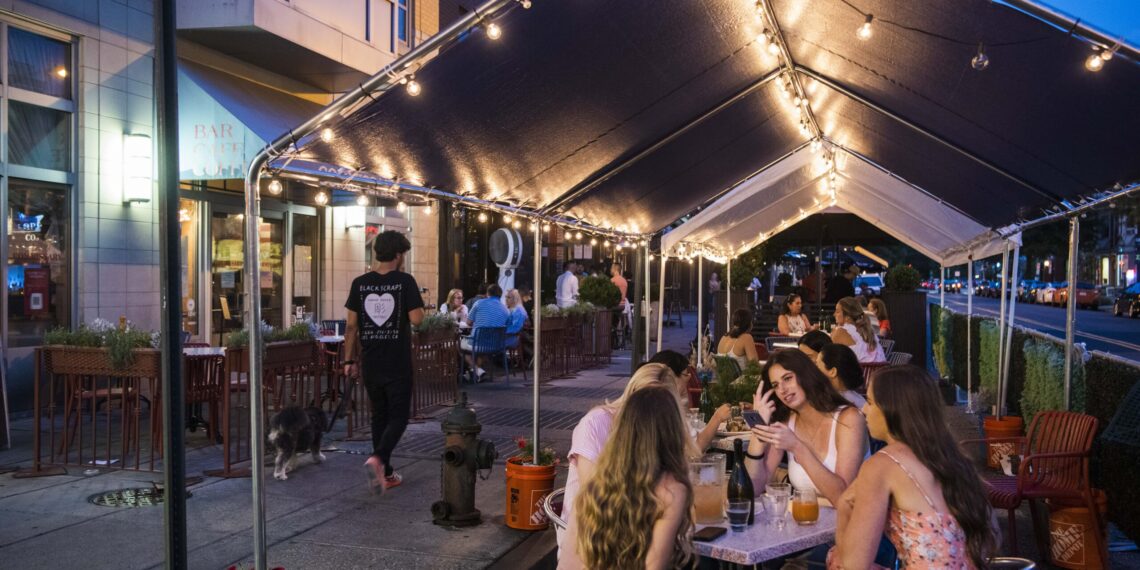Restaurant owners across Washington are crunching the numbers to see if they can afford to keep the streateries that helped them survive the pandemic as the city plans to sunset a temporary program for the eateries at the end of the month and install a new, more costly one.
Owners say the District Department of Transportation’s new guidelines, fee structures and permitting processes will probably cost too much to make streateries worthwhile, or force proprietors to dramatically alter the size and durability of their structures to accommodate the rules that go into effect Dec. 1. But DDOT says the guidelines and regulations are vital to maintaining public safety while also setting design standards that can avoid the kind of streateries that critics have labeled eyesores or blights to the neighborhood.
Restaurant owners across Washington are crunching the numbers to see if they can afford to keep the streateries that helped them survive the pandemic as the city plans to sunset a temporary program for the eateries at the end of the month and install a new, more costly one.
Owners say the District Department of Transportation’s new guidelines, fee structures and permitting processes will probably cost too much to make streateries worthwhile, or force proprietors to dramatically alter the size and durability of their structures to accommodate the rules that go into effect Dec. 1. But DDOT says the guidelines and regulations are vital to maintaining public safety while also setting design standards that can avoid the kind of streateries that critics have labeled eyesores or blights to the neighborhood.
“There are some safety concerns,” DDOT Director Sharon Kershbaum said in reference to the streateries. “There are walls where there’s a lot of visibility challenges. There are those that are too close to the crosswalks and intersections and alleys. There’s accessibility issues, and there’s aesthetic issues.”
Under the temporary program, which has been in place since June 2020, restaurants did not pay for use of public spaces to run their streateries. They were also given latitude in the size, scope and location of their streateries, many of which were enclosed enough to allow year-round operations. The new guidelines will change much of that.
Those who want to operate a streatery in the District will have to pay $260 for a permit, plus $20 per square foot in annual fees. They also will be required to supply their own jersey barriers, heavy three-foot-tall concrete walls that would protect customers from oncoming traffic. Should owners want to rent such barriers from the city, it will cost them $250 per barrier, plus a $500 deposit. Then there are the fees associated with the many documents, including architectural designs, that will be needed to submit an application.
Some owners say the costs no longer justify the potential benefits. Their gloomy opinion is based, in part, on guidelines that prohibit operators from enclosing streateries for year-round dining, limiting their use to warm-weather months. DDOT argues enclosed streateries can impair visibility even with clear-plastic sides or windows, which can create glare.
Jo-Jo Valenzuela, chef and co-owner of Tiki on 18th in Adams Morgan, has crunched the numbers. “If you do the math, it was going to cost us around like $13,000 a year,” Valenzuela told The Washington Post. “That just doesn’t make any sense anymore.”
One of his calculations: Tiki’s revenue has declined significantly this year, partially because the city installed a new, smaller, open-air streatery there as part of a pilot program. The outdoor space didn’t attract customers like the bar’s original streatery, a spacious wooden structure with a roof and heaters, Valenzuela said.
Two dozen advisory neighborhood commissioners, business improvement district executives, restaurant owners and members of the general public testified about streateries last Thursday during a meeting of the Committee on Transportation and the Environment chaired by D.C. Council member Charles Allen (D-Ward 6). Almost everyone supported a permanent streatery program, but many warned that DDOT’s current plan could hurt business, eliminate jobs and even lead to the closure of restaurants that still rely on streateries for survival, many months after the pandemic ended.
Robert Wing, co-owner of Mikko in Dupont Circle, said his Nordic restaurant survived covid-19 specifically because of its streatery, which more than doubles the capacity of the 14-seat establishment. “We likely would have to close if we have to remove our streatery,” he testified. “It really is the difference between being in operation or not.”
In interviews with The Washington Post, several restaurateurs noted that streateries have morphed from a pandemic-era remedy to an essential part of their business plan, helping to spur growth.
Patrice Cleary, the chef and owner of Purple Patch in Mount Pleasant, estimates that between 40 and 50 percent of her revenue is directly related to her streatery, which covers 12½ parking spots, including those in front of neighboring businesses. Last year, she said, Purple Patch generated more than $4 million in gross sales, more than double the $1.9 million she earned in 2019. Last year, her sales translated into more than $438,000 in sales and use taxes for the District, she noted, nearly half from streatery sales.
If unable to participate in the permanent program, “we’d be forced to lay off approximately 40 percent of our workforce,” Cleary testified Thursday. “Currently, we have 65 employees. That would mean laying off 26 employees to go back down to our pre-pandemic numbers of 39 employees.”
What’s more, restaurant owners say, they have already been dealing with shocks to the system: rising food and labor costs; a federal crackdown on immigrant workers, who represent a significant part of the restaurant labor force; federal government layoffs; tariffs; and now the longest government shutdown in U.S. history. The new streatery program feels like one more shock.
“A lot of restaurants are feeling like we are in another pandemic,” said Shawn Townsend, president and chief executive of the Restaurant Association Metropolitan Washington, a trade association that represents the local hospitality industry. “There are pandemic-like symptoms that the industry is faced with, and I think government has a responsibility to be strategic on how they can provide support to restaurants.”
In a statement to The Post, Allen said that if DDOT doesn’t make some changes to its permanent guidelines, he would take legislative action.
“I fully support permanent regulations, but the current rules limit the utility of streateries when the weather isn’t ideal and the cost is going to be prohibitive,” Allen said. “I think DDOT should think very carefully about what we will lose if the rules or fees are overly burdensome — not only does a busy streatery generate far more in sales and use tax than a parking spot, but it creates the kind of atmosphere we all want.”
Critics say that not all streateries are busy, vibrant spaces; some have become trash receptacles or furniture storage that block traffic and curbside access. “It’s a land grab,” said Stefanie Scott, co-chair of a group called Georgetown Coalition for Public Spaces that has protested the streatery status quo. “They’re squatting, and they don’t want to release it, and they don’t want to pay for it.”
The group doesn’t agree with all the DDOT rules — it would like to see jersey barriers removed and streateries made seasonal — but say it’s willing to accept compromise while the restaurant industry is not. “The second we get close to regulations, then it’s an emergency again that everybody’s going to go out of business and anybody who’s against this wants everybody to go out of a business,” co-chair Elizabeth Miller said. “And that’s just not the case, and it’s not true.”
In drafting the fee structures for the permanent program, Kershbaum said her staff reviewed streateries in other cities. She said D.C.’s fees are in line with those in Alexandria, Virginia; Boulder, Colorado; and New York. What’s more, Kershbaum noted, is that District parking spots are worth about $113 per square foot, based on the annual revenue they generate. Charging only $20 per square foot, she said, is essentially a city subsidy of nearly $95 per square foot for restaurants.
DDOT says it has shown flexibility in drafting the guidelines after speaking with a number of parties, including restaurants, the Restaurant Association Metropolitan Washington, advisory neighborhood commissions and other groups. The agency, Kershbaum said, slashed its proposed annual fees from $35 per square foot to $20 per square foot. It has also worked with restaurants to lift restrictions on parking spaces that convert to traffic lanes during rush hour, helping owners whose temporary streatery permits would have expired Nov. 30 under new guidelines that prohibit the structures on rush-hour streets.
The Immigrant Food location at the Planet Word museum was the beneficiary of such a rush-hour designation change, said Téa Ivanovic, co-founder of the local chain. Its streatery on 13th Street NW sits in a lane that’s supposed to be open to traffic during rush hour, but the city removed the designation, Ivanovic said. It’s a mercy to Immigrant Food, which relies on the streatery not just for revenue but as a form of outdoor advertising. Since the restaurant is in a historic building, Immigrant Food is limited in how much signage it can put up to attract customers, she said.
People “don’t see that we’re there, so having a beautiful patio, a beautiful streatery is critical for us,” Ivanovic told The Post. “I mean, it’s almost like make or break to the business.”
DDOT has also made changes to the application process. If owners apply for a permanent permit by Nov. 30, the agency will allow owners to keep operating their streateries as the application winds through the review process. So far, Kershbaum said, 62 of the 139 restaurants with temporary streatery permits have applied. She expects more by the deadline. She also noted that 33 permit holders have told DDOT that they’re not interested in a permanent streatery.
Even if operators don’t apply by Nov. 30, DDOT doesn’t plan to start dismantling streateries that are no longer in compliance. Kershbaum doesn’t expect DDOT to begin enforcement until “early 2026,” which is likely to start with warning letters.
“Our goal is to work with streateries and restaurants to become compliant,” she said. “But we need to have deadlines.”
The post After five years, D.C. streateries hit with higher costs and more rules
appeared first on Washington Post.




